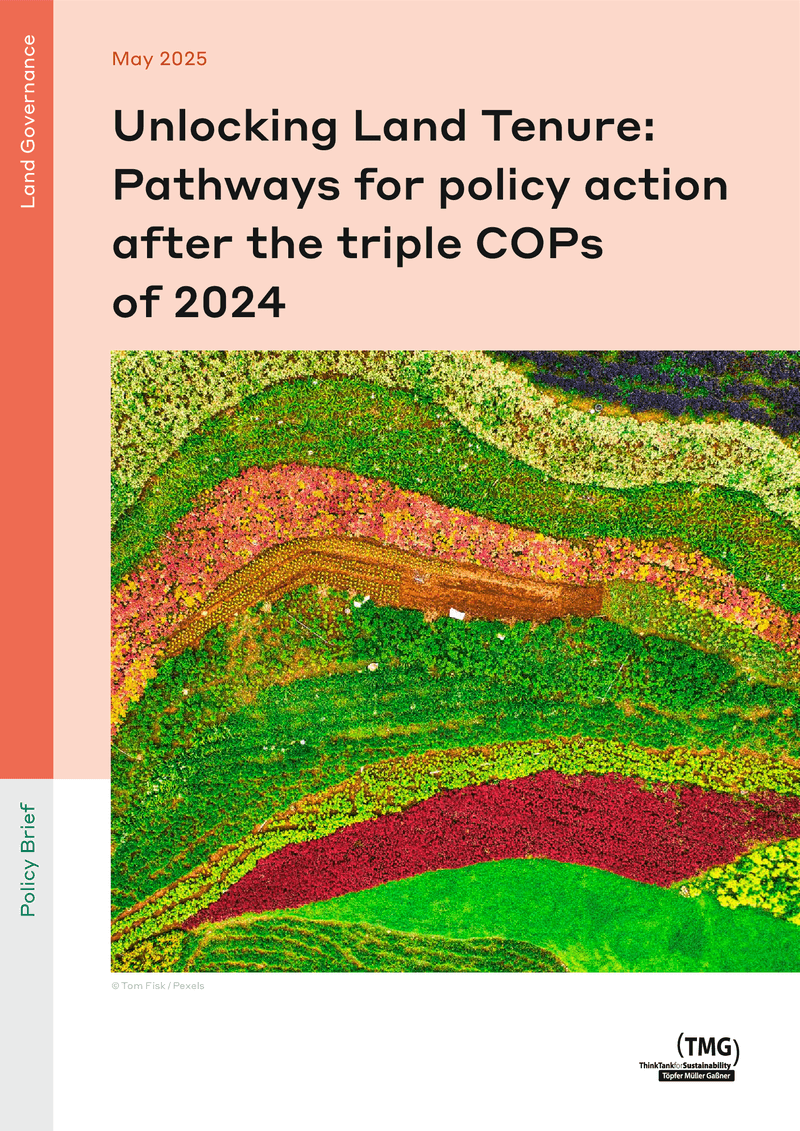The 2024 triple-COP year presents a key opportunity to elevate land tenure and land rights in global environmental governance. For the first time, the UN Convention on Biological Diversity (CBD), the UN Convention to Combat Desertification (UNCCD), and the UN Framework Convention on Climate Change (UNFCCC) held their Conferences of the Parties (COPs) in the same year. This policy brief provides the first ever cross-Convention synthesis of land tenure-related outcomes, with a focus on the rights of Indigenous Peoples and Local Communities (IPLCs), women’s land rights, and the potential for inter-Convention cooperation. Although the UNCCD continues to be the leading forum for land tenure discussions, the CBD has made important progress through new monitoring indicators and institutional reforms. Meanwhile, the UNFCCC lags behind, raising concerns about fragmented governance and lost opportunities to integrate human rights into climate negotiations. Against a backdrop of shrinking civic space and geopolitical fragmentation, it is vital that entry points for action remain visible and accessible in order to catalyze change. This brief identifies key decisions across the triple-COP year and maps entry points, both direct and indirect, for coordinated advocacy, programming, and policy alignment. It offers timely guidance for decision-makers and stakeholders navigating the complex, and often contested, terrain of multilateral land governance.
Introduction
Amid growing challenges to multilateral cooperation and the rise of nationalist and isolationist agendas, the world faces a critical inflection point. The ability to collectively address the triple planetary crisis – climate change, biodiversity loss, and land degradation – is increasingly jeopardized. Democratic spaces are shrinking, geopolitical fragmentation is deepening, and trust in international processes is waning. Against this backdrop, it is more urgent than ever to ensure that entry points for action remain accessible, visible, and grounded in justice. Land and land tenure systems are not just technical elements of environmental governance; they are political, economic, and cultural pillars that determine who benefits from climate and conservation finance, who participates in decision-making, and who bears the risks of inaction.
Land rights and land tenure security are essential to ensuring that climate and conservation efforts are fair, inclusive, and effective. Secure land tenure is a critical component of climate action, as it empowers Indigenous Peoples and Local Communities (IPLCs) and women to participate in decision-making processes and benefit from climate mitigation and adaptation efforts (TMG 2024a). Weak land rights exclude marginalized groups from environmental and economic benefits, undermining global efforts to fight climate change and biodiversity loss. Unclear tenure rights can increase conflicts, reduce incentives for sustainable management, and hamper the effectiveness of conservation, restoration, and sustainability projects (TMG 2024b). Strong land tenure systems are foundational for ensuring that carbon markets, restoration, and conservation initiatives meet equitable and sustainable outcomes (Rights and Resources Initiative & McGill University 2024).
Land tenure also plays a crucial role in closing gender gaps and ensuring women can actively contribute to climate solutions (see Table 2). Women’s land rights remain disproportionately weak, with over 70 per cent of women in many countries lacking formal land ownership (Stanley & Lisher 2023). Secure land rights enable women to participate in land use decisions, improving their ability to manage resources sustainably and invest in climate-resilient practices. Without targeted interventions to strengthen women’s tenure security, existing gender inequalities will continue to be reinforced (FAO & UNCCD 2022).
The alignment of the 2024 Rio Conventions presented a key opportunity to strengthen global land tenure commitments. For the first time, the UN Convention on Biological Diversity (CBD), the UN Convention to Combat Desertification (UNCCD), and the UN Framework Convention on Climate Change (UNFCCC) held their Conferences of the Parties (COPs) in the same year. This alignment creates opportunities to coordinate policies, integrate land tenure into climate and biodiversity goals, and ensure land governance frameworks to support sustainable development (Rackelmann et al. 2024).
Previous studies have examined just transitions (Aleksandrova et al. 2024), landscape restoration (Sewell, et al. 2020), and gender equality (UN Women 2024), as well as emphasizing the importance of enhanced synergies among the Rio Conventions (Tsioiumani 2024). However, these analyses have not specifically adopted land tenure and land rights as a central lens. This policy brief examines the outcomes of the 2024 triple-COP year, analyzing decisions relevant to land tenure, land rights, women’s land rights, and broader gender and human rights. Rio Convention COP decisions are presented according to broad themes including Land Tenure, Gender, IPLCs, Indicators and Monitoring, Inter-Convention Synergies, and Human Rights. From this analysis, actionable entry points are identified for civil society organizations (CSOs), national focal points (NFPs), women’s caucuses, and the Secretariats of the Rio Conventions to create synergies that strengthen the protection and recognition of land rights and integrate land rights into future COP discussions and policies. The policy brief is complemented by an in-depth technical report.
Women’s Land Rights Initiative
The Women's Land Rights Initiative (WRLI), hosted by TMG, the Robert Bosch Stiftung, Huairou Commission, UNCCD, UNFCCC and CBD, is a network of more than 60 partners dedicated to systematically embedding women’s land rights within the three UN Rio Conventions on biodiversity, desertification, and climate change. The WLRI aims to enhance coordination across the Conventions to safeguard women’s land rights, promote gender-equitable land governance, and support women’s active role in climate action. Through strategic collaboration, knowledge-sharing, and advocacy, the WLRI ensures that global decisions are informed by local realities and prioritize women’s meaningful contributions to advancing the Conventions’ goals. Outcomes from the WLRI workshop were reviewed for this report and were built on to strengthen or identify relevant entry points for synergies.






